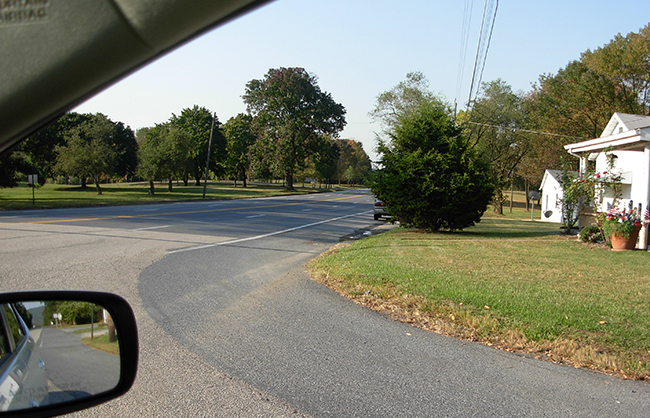Sight Distance

When motorists approach an intersection, obstructions such as signs, buildings, fences, and trees may block the motorist's view of approaching vehicles. Inadequate sight distance causes motorists to edge out into the intersection, increasing the potential for crashes. Required intersection sight distance is based on traffic control, roadway width, approach speed, and design vehicle.
There are several different types of sight distance at intersections that must be accounted for, based on the variables identified above.
No Control: All approach legs must have sight distance approaching the intersection.
Stop Control: Left-Turn from the Minor Road: This sight distance is needed for motorists to see oncoming traffic from both directions on the major road in order to determine if they have enough time to complete their left turn maneuver.
Stop Control: Right-Turn from the Minor Road: This sight distance is needed for motorists to see oncoming traffic from the left in order to determine if they have enough time to complete their right turn maneuver.
Stop Control: Crossing Maneuver from the Minor Road: This sight distance is needed for motorists to see oncoming traffic from both directions in order to determine if they have enough time to complete their crossing maneuver.
Yield Control: Left- or Right-Turn from the Minor Road: This sight distance is needed for motorists to see oncoming traffic in order to determine if they have enough time to complete their turning maneuver.
Yield Control: Crossing Maneuver from the Minor Road: This sight distance is needed for motorists to see oncoming traffic from both directions in order to determine if they have enough time to complete their crossing maneuver.
Traffic Signal Control: The operation of the signal and the prohibition of right-turns-on-red affect the requirement for sight distance. If right turns are prohibited on red, then no sight distance is needed. If right turns are allowed on red, then the calculation used for Stop Control: Right-Turn from the Minor Road must be performed.
All-Way Stop Control: Since all traffic stops at the intersection, there is no sight distance needed.
Left-Turns from Major Road: This sight distance is needed for motorists to see oncoming traffic on the major road in order to determine if they have enough time to complete their crossing maneuver.
The Intersection Sight Distance Calculator portion of this module calculates and graphically depicts all of these scenarios based on all of the inputs necessary. If an object blocks sight distance based on the values calculated, it should be removed. If a vertical curve limits sight distance, consider regrading. Other possible remedies can include changes to traffic control, turn restrictions, speed limit reductions. These remedies should only be done after a professional engineering study. Contact TEA for assistance.


